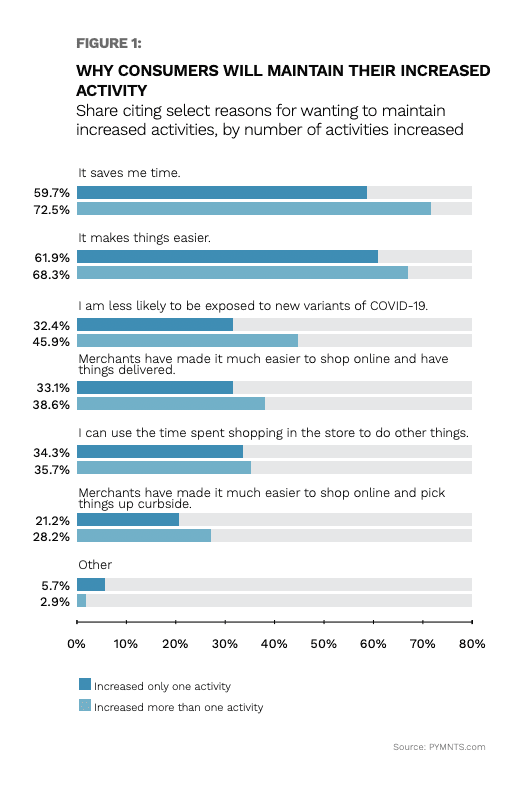PYMNTS Pandenomics Study: Many Shifters Prefer Digital Living To The Physical World

Retailing will never be the same as it was just 15 months ago. Yet what began as an emergency is evolving into something else entirely: the much-discussed but rarely defined “next normal” of living, shopping, paying and interacting in a rising digital-first world.
For the latest installment in PYMNTS’ Pandenomics series, Consumers and the New Retail Landscape, researchers surveyed 2,225 consumers to create a 3D view of trends in shopping and payments as vaccinations and other factors influence consumer decisions online and off.
As for the march of science, the May 2021 Pandenomics study notes that nearly 60 percent of respondents had gotten at least one vaccine jab, noting that “vaccinated consumers have different indoor options than unvaccinated people in many states, such as flexible, non-distanced seating and unmasked seating at sporting events and theaters.”
Options to reengage with the physical world are great for the vaccinated, but that doesn’t mean people intend to abandon all eCommerce shopping activities and head to the mall. Digital habits acquired in the pandemic are sticky, because they make life easier.
 Not All Vaccinated People Want the ‘Old Ways’ Back
Not All Vaccinated People Want the ‘Old Ways’ Back
A perfect illustration of why even vaccinated people will stick to digital is found in the new Pandemonics report, stating that “most consumers (52 percent) have adopted the use of digital shopping aggregators, such as Instacart or Grubhub, which allow them to shop or order from multiple stores or restaurants at once. Large shares of consumers who have increased their activity for a range of tasks that include grocery or retail shopping since early 2020 cite saving time as the top reason why they want to maintain these shifted behaviors for one activity (60 percent) or two or more (72 percent).”
It started as a safety precaution, but the web of connected omnichannel commerce is emerging as a powerhouse of payments tech, analytics and logistics, creating attractive new models.
In fact, PYMNTS researchers found data suggesting that “fully vaccinated digital shifters may be less likely than non-shifters to actually carry out their plans to embrace public leisure activities again. This may be because digital shifters are still hesitant to return to familiar activities, even with more free time, due to time-saving digital choices or because these activities have become less attractive over time due to individuals’ comfort with digital interactions. This finding indicates that digital shifters’ new behavior patterns may persist.”
It begs the question: Can reality compete with the virtual world? It can, but merchants have to step up their transformation timetables and make stores behave more like websites and apps.
New digital options are taking on “familiar local favorite grocers next to national retailers with same-day shipping, vast inventories and frequent clearance prices,” which provides “ample motivation for local retailers to engage consumers returning to outdoor and indoor activities,” per Pandenomics. “The majority of consumers have used digital shopping aggregators, yet those most likely to be adopters are millennials (81 percent), members of Generation Z (80 percent) and consumers who earn more than $100,000 annually (58 percent).”
 Possible Implications for Delivery Aggregators
Possible Implications for Delivery Aggregators
A close read of the latest Pandenomics report reveals that despite the allure of sheer efficiency of digital-first living, it’s going to get tested by the return of the real world.
“Fully vaccinated delivery aggregator users have increased the frequency of their shopping in grocery stores more than vaccinated non-users (27 percent versus 11 percent, respectively), shopping in non-grocery retail stores (28 percent versus 8 percent for non-users) and eating out (23 percent versus 8 percent for non-users),” per the new report.
Unvaccinated consumers using delivery aggregators also “show a greater enthusiasm for future in-person leisure activities, unlike other consumers,” according to the new research. “This may be due to their interest in time-saving activities that free them up to pursue the activities they may otherwise have missed.”
If we’ve learned nothing else, it’s that things can change faster than we thought possible. As of this moment in time, new patterns are still forming. Still, this data makes a few things clearer.
“Despite the availability of the vaccine and the relaxing of restrictions on store and restaurant hours across the country, most respondents still value the efficiency of delivery for food and groceries,” stated the new Pandenomics Report. “This is unsurprising, as consumers — who spend an average of 16 hours per day online consuming digital media — would have little incentive to abandon digital behaviors that are at their fingertips and save them time with a few clicks. Three-quarters of digital shifters state that they will maintain at least one behavioral change they acquired during this eventful year.”
